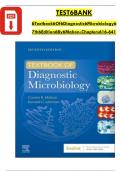TEST6BANK
6Textbook6Of6Diagnostic6Microbiology6
7th6Edition6By6Mahon6Chapters616-641
, Mahon:6Textbook6of6Diagnostic6Microbiology,67th6Edition6Test6Bank
Table6of6contents
Part61:6Introduction6to6Clinical6Microbiology
Chapter61.6Bacterial6Cell6Structure,6Physiology,6Metabolism,6and6Genetics
Chapter62.6Host-Parasite6Interaction
Chapter63.6The6Laboratory6Role6in6Infection6Control
Chapter64.6Control6of6Microorganisms:6Disinfection,6Sterilization,6and6Microbiology6Safety
Chapter65.6Performance6Improvement6in6the6Microbiology6Laboratory
Chapter66.6Specimen6Collection6and6Processing
Chapter67.6Microscopic6Examination6of6Materials6from6Infected6Sites
Chapter68.6 Use6of6Colony6Morphology6for6the6Presumptive6Identification6of6Microorganisms
Chapter69.6 Biochemical6Identification6of6Gram-Negative6Bacteria
Chapter610.6Immunodiagnosis6of6Infectious6Diseases
Chapter611.6Applications6of6Molecular6Diagnostics
Chapter612.6Antibacterial6Mechanisms6of6Action6and6Bacterial6Resistance6Mechanisms
Chapter613.6Antimicrobial6Susceptibility6Testing
Part62:6Laboratory6Identification6of6Significant6Isolates
Chapter614.6Staphylococci
Chapter615.6Streptococcus,6Enterococcus,6and6Other6Catalase-Negative,6Gram-Positive6Cocci
Chapter616.6Aerobic6Gram-Positive6Bacilli
Chapter617.6Neisseria6Species6and6Moraxella6catarrhalis
Chapter618.6Haemophilus,6HACEK,6Legionella6and6Other6Fastidious6Gram-Negative6Bacilli
Chapter619.6Enterobacteriaceae
Chapter620.6Vibrio,6Aeromonas,6and6Campylobacter6Species
Chapter621.6Nonfermenting6and6Miscellaneous6Gram-Negative6Bacilli
Chapter622.6Anaerobes6of6Clinical6Importance
Chapter623.6The6Spirochetes
Chapter624.6Chlamydia,6Rickettsia,6and6Similar6Organisms
Chapter625.6Mycoplasma6and6Ureaplasma
Chapter626.6Mycobacterium6tuberculosis6and6Nontuberculous6Mycobacteria
Chapter627.6Medically6Significant6Fungi
Chapter628.6Diagnostic6Parasitology
Chapter629.6Clinical6Virology
Chapter630.6Agents6of6Bioterror6and6Forensic6Microbiology
Chapter631.6Biofilms:6Architects6of6Disease
Part63:6Laboratory6Diagnosis6of6Infectious6Diseases:6and6Organ6System6Approach6to6Diagnostic6Microbi
ology
Chapter632.6Upper6and6Lower6Respiratory6Tract6Infections
Chapter633.6Skin6and6Soft6Tissue6Infections
Chapter634.6Gastrointestinal6Infections6and6Food6Poisoning
Chapter635.6Infections6of6the6Central6Nervous6System
Chapter636.6Bacteremia6and6Sepsis
Chapter637.6Urinary6Tract6Infections
Chapter638.6Genital6Infections6and6Sexually6Transmitted6Infections
Chapter639.6Infections6in6Special6Populations
Chapter640.6Zoonotic6Diseases
Chapter641.6Ocular6Infections
-
,Chapter601:6Bacterial6Cell6Structure,6Physiology,6Metabolism,6and6Geneti
cs6Mahon:6Textbook6of6Diagnostic6Microbiology,67th6Edition6Test6Bank
MULTIPLE6CHOICE
1. To6survive,6microbial6inhabitants6have6learned6to6adapt6by6varying6all6of6the6following,6except
a. growth6rate.
b. growth6in6all6atmospheric6conditions.
c. growth6at6particular6temperatures.
d. bacterial6shape.
ANS:6D
The6chapter6begins6by6discussing6the6way6microbial6inhabitants6have6had6to6evolve6t
o6survive6in6many6different6niches6and6habitats.6It6discusses6slow6growers,6rapid6grow
ers,6and6replication6with6scarce6or6abundant6nutrients,6under6different6atmospheric6con
ditions,6temperature6requirements,6and6cell6structure.6Bacterial6shape6as6a6form6of6ev
olution6is6not6discussed.
OBJ:6Level62:6Interpretation
2. Who6was6considered6the6father6of6protozoology6and6bacteriology?
a. Anton6van6Leeuwenhoek
b. Louis6Pasteur
c. Carl6Landsteiner
d. Michael6Douglas
ANS:6A
The6book6discusses6Anton6van6Leeuwenhoek6as6the6inventor6of6the6microscope6and6the
6first6person6to6see6the6“beasties.”6So6they6dubbed6him6the6father6of6protozoology6
and6bacteriology.6The6other6three6individuals6were6not6discussed.
OBJ:6Level61:6Recall
3. Prokaryotic6cells6have6which6of6the6following6structures6in6their6cytoplasm?
a. Golgi6apparatus
b. Ribosomes
c. Mitochondria
d. Endoplasmic6reticulum
ANS:6 B
All6the6structures6listed6are6found6in6eukaryotic6cells,6but6ribosomes6are6the6only6
ones6that6apply6to6prokaryotic6cells.
OBJ:6Level61:6Recall
4. This6form6of6DNA6is6commonly6found6in6eukaryotic6cells.
a. Linear
b. Circular
c. Plasmid
d. Colloid
.
.
, ANS:6A
Circular6and6plasmid6DNA6are6usually6found6only6in6bacteria,6not6eukaryotic6cells.6C
olloid6is6a6property6of6protein6molecules6and6is6not6associated6with6nucleotides.
OBJ:6Level61:6Recall
5. The6nuclear6membrane6in6prokaryotes6is
a. missing.
b. impenetrable.
c. a6classic6membrane.
d. a6lipid6bilayer6membrane.
ANS:6A
Prokaryotic6cells6do6not6have6any6membrane-
bound6structures6in6the6cytoplasm6including6a6structured6nucleus.
OBJ:6Level61:6Recall
6. A6microorganism6that6is6a6unicellular6organism6and6lacks6a6nuclear6membrane6a
nd6true6nucleus6belongs6to6which6classification?
a. Fungi
b. Bacteria
c. Algae
d. Parasite
ANS:6 B
Fungi,6algae,6and6parasites6are6unicellular6eukaryotic6organisms6that6contain6a6true6
nucleus.6Bacteria6are6prokaryotic6and6do6not6contain6a6true6nucleus6or6nuclear6mem
brane.
OBJ:6Level61:6Recall
7. In6the6laboratory,6the6clinical6microbiologist6is6responsible6for6all6the6following,6except
a. isolating6microorganisms.
b. selecting6treatment6for6patients.
c. identifying6microorganisms.
d. analyzing6bacteria6that6cause6disease.
ANS:6 B
Clinical6microbiologists6do6not6select6the6treatment6for6patients.6They6provide6the6doct
or6with6the6name6of6the6organism6and6the6antibiotics6that6can6kill6the6bacteria,6but6n
ot6in6the6final6selection6of6treatment6protocols.
OBJ:6Level62:6Recall
8. What6enables6the6microbiologist6to6select6the6correct6media6for6primary6culture6and6
optimize6the6chance6of6isolating6a6pathogenic6organism?
a. Determining6staining6characteristics
b. Understanding6the6cell6structure6and6biochemical6pathways6of6an6organism
c. Understanding6the6growth6requirements6of6potential6pathogens6at6specific6body6site
d. Knowing6the6differences6in6cell6walls6of6particular6bacteria
ANS:6C




